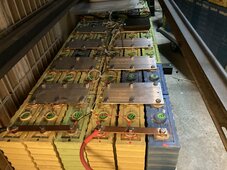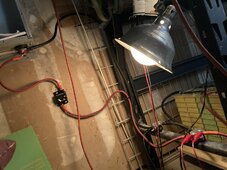One question… Is DIY TOU arbitrage legal in CA?
I have EV-TOU because of my EV pursuits; been charging my cars from 12>6AM for the last two years.
I am an EV conversion guy, made myself a battery wall from regular old prismatic LiFeP04 cells taken out of EV's at 80% of original capacity. Virtually free battery wall, 24KWH. 3P20S connected with 4x7x1/4" aluminum plates and adequately sized copper bus bars. (Photo attached.) Plenty enough juice to cover my house usage, excluding car charging, which happens from midnight to 6 AM anyway, and does not go through the inverter.
Very simple system, actually. No solar, no back up gen. Just batteries, an inverter and an external charger on a timer.
I am quite competent to design and install this system to code...and I have a licensed electrician friend to double check my work for any code violations, and provide certification to my insurance company if necessary.
Skipping all the unnecessary (for this question) design details:
110/240VAC: Grid Panel>Inverter>House Panel>House Loads (Photo attached)
68VDC: Batteries>Inverter (Photo attached)
240VAC/68VDC:
Grid Panel>Timer>Charger>Batteries
Cost: 2400 bucks for a brand-new Outback inverter, a few hundred more for a brand-new Intermatic timer and used Elcon charger (removed from a car and reprogrammed,) new copper wire and conduit, breakers and breaker panel, etc. I did the math and will save about half of my previously $225-250/month bill. The payback on that is pretty short... about 18-24 months.
In the EV world, you do pretty much what you want, without any oversight or enforcement. The only governing laws are those of physics and engineering. No politics, no goobermint inspectors or enforcers.
But house electrical systems have codes, oversight, enforcement and insurance implications. Not to mention nosy neighbors.
Is there anything unlawful about doing this myself, or using TOU to charge house batteries from midnight to six?
Do I have to get permits for any of this? I'm not interested in any gooberment incentives or "benefits," just in saving half my bill. I will interface with them when absolutely necessary, to get my TOU rates, for example. But in general, the further away you keep me from any gummint or investigative or legal agencies, judges, lawyers, corporations or pissed off power companies, or anybody else with the power to make me do something that doesn't make sense, the happier I stay.
I have EV-TOU because of my EV pursuits; been charging my cars from 12>6AM for the last two years.
I am an EV conversion guy, made myself a battery wall from regular old prismatic LiFeP04 cells taken out of EV's at 80% of original capacity. Virtually free battery wall, 24KWH. 3P20S connected with 4x7x1/4" aluminum plates and adequately sized copper bus bars. (Photo attached.) Plenty enough juice to cover my house usage, excluding car charging, which happens from midnight to 6 AM anyway, and does not go through the inverter.
Very simple system, actually. No solar, no back up gen. Just batteries, an inverter and an external charger on a timer.
I am quite competent to design and install this system to code...and I have a licensed electrician friend to double check my work for any code violations, and provide certification to my insurance company if necessary.
Skipping all the unnecessary (for this question) design details:
110/240VAC: Grid Panel>Inverter>House Panel>House Loads (Photo attached)
68VDC: Batteries>Inverter (Photo attached)
240VAC/68VDC:
Grid Panel>Timer>Charger>Batteries
Cost: 2400 bucks for a brand-new Outback inverter, a few hundred more for a brand-new Intermatic timer and used Elcon charger (removed from a car and reprogrammed,) new copper wire and conduit, breakers and breaker panel, etc. I did the math and will save about half of my previously $225-250/month bill. The payback on that is pretty short... about 18-24 months.
In the EV world, you do pretty much what you want, without any oversight or enforcement. The only governing laws are those of physics and engineering. No politics, no goobermint inspectors or enforcers.
But house electrical systems have codes, oversight, enforcement and insurance implications. Not to mention nosy neighbors.
Is there anything unlawful about doing this myself, or using TOU to charge house batteries from midnight to six?
Do I have to get permits for any of this? I'm not interested in any gooberment incentives or "benefits," just in saving half my bill. I will interface with them when absolutely necessary, to get my TOU rates, for example. But in general, the further away you keep me from any gummint or investigative or legal agencies, judges, lawyers, corporations or pissed off power companies, or anybody else with the power to make me do something that doesn't make sense, the happier I stay.





